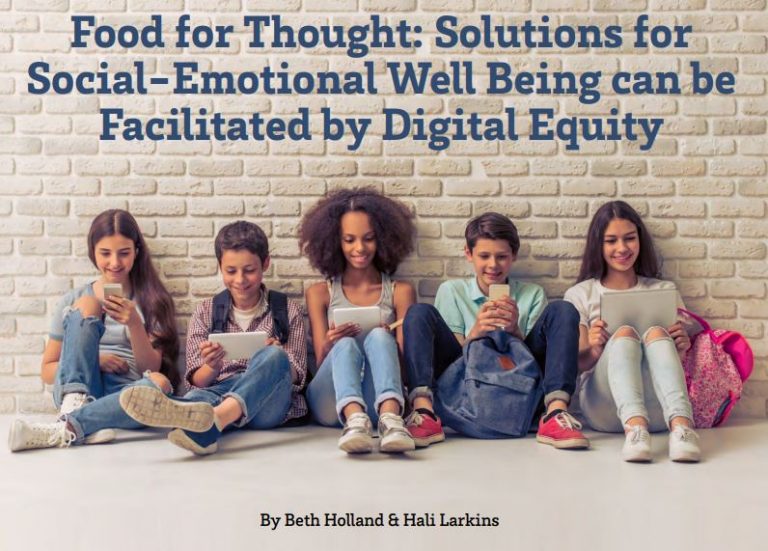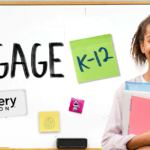Digital equity and social-emotional practices are rarely discussed in tandem. Conversations about digital equity often focus on enhancing capacities for learning through technology, while social-emotional efforts tend to focus on building avenues for positive self-awareness and community building.
In reality, given the demands currently placed on our education system, the challenges and gaps associated with technology use — both internet and device access — as well as social-emotional well being have become interconnected.
Digital Equity
For decades, extensive research has documented digital technology disparities that the COVID-19 pandemic has only exacerbated. A 2021 Study by Common Sense Media and Boston Consulting Group found that despite a 20-40% increase in students who have been connected since the pandemic started, over 12 million students still do not have adequate home internet access or the digital devices necessary to access remote or hybrid learning resources at home.
According to a survey administered during COVID-19 by Upbeat, the issue of digital inequity remains prevalent across socioeconomic lines: 87% of students in low-poverty schools report having adequate technology access as compared to only 64% of students in high-poverty schools.
Shifting the Conversation From Devices to Include Social-Emotional Supports
A newly published report from New America further documents that students are not only unconnected but under-connected. Students may have access to a device or the internet, but it is not sufficient to fully participate in class, complete schoolwork, or interact with multimedia.
Additionally in a review of school’s responses to remote learning, the Teaching Systems Lab at MIT found that schools reporting more consistent at-home broadband access also implemented more comprehensive strategies for remote and hybrid learning. The report also highlighted that for teachers who work in communities where students have limited technology access at home, trying to sustain students’ relationships and connections with schools consumed a substantial portion of teachers’ energy. These findings suggest that students’ varying levels of resources shaped their teachers’ abilities to deliver comprehensive learning solutions and experiences during the pandemic.
When children do not have access to digital tools for formal learning, they also often lack mental health supports such as online spaces to express their feelings (text, email, direct messaging, etc.) and apps for mental health. This disparity consequently impacts their learning experiences.
Connectedness and Social-Emotional Well Being
Technology can serve as a valuable resource for alleviating social-emotional challenges within student populations. However, when access becomes a barrier, the potential for technology in that manner is also limited. Not having access to digital tools impacts how students can engage with their teachers and peers, as well as build community when their in-person connections are limited or absent due to safety restrictions. For example, a report by The Learning Accelerator (TLA) about Lindsay Unified School District’s (LUSD) student learning experience during Covid-19 highlighted that community was a critical component of remote-learning.
As a district, LUSD has committed to digital equity by ensuring that all technology users can access online technologies at any time and from anywhere. This study highlighted that the districts’ efforts around connectivity also allowed teachers to focus more on social-emotional wellbeing resulting in students feeling safe, cared for, and supported. Such efforts would not have been possible in an online context if every student did not have access to the necessary tools.
Additionally, a 2020 report by Common Sense on the state of adolescents’ mental health in an increasingly digital world found that connected adolescents use social media to stay connected and get critical information. The report also highlighted that digital media and technology could serve as a social safety net. For communities that are under-resourced, solely solving issues around connectivity without supplemental social-emotional supports (such as specific strategies to ensure that students feel connected in online environments and can access digital mental health tools) and only deepens systemic inequalities.
Considerations for Policymakers and System Leaders

Students need access to resources that can allow them to utilize technology not only for learning but also in ways that positively impact their social emotional well being. This upcoming school year presents an opportunity for school leaders to implement new supports for districts that enhance digital connectivity and simultaneously provide students with outlets and tools that can enhance their mental health.
In the context of supporting students’ emotional safety and wellbeing during the pandemic, the Center of Reinventing Public Education (CRPE) identified that only 66% of school districts across the U.S. aimed to intentionally address students’ social and emotional wellbeing in remote and hybrid learning environments. Districts can take advantage of resources for improving digital equity through programs for device and broadband access (such as ARP and Erate). While doing so, CRPE recommends that districts can also support social-emotional wellbeing by establishing, “a strategy that includes a clear vision for social-emotional learning, strong communication, and data.”
By addressing digital equity with social well being in mind, school leaders and policymakers can set our education system — and most importantly our students — up for success.
The American Consortium for Equity in Education, publisher of the "Equity & Access" journal, celebrates and connects the educators, associations, community partners and industry leaders who are working to solve problems and create a more equitable environment for historically underserved pre K-12 students throughout the United States.
- American Consortium for Equity in Educationhttps://ace-ed.org/author/admin/
- American Consortium for Equity in Educationhttps://ace-ed.org/author/admin/April 23, 2025
- American Consortium for Equity in Educationhttps://ace-ed.org/author/admin/
- American Consortium for Equity in Educationhttps://ace-ed.org/author/admin/







